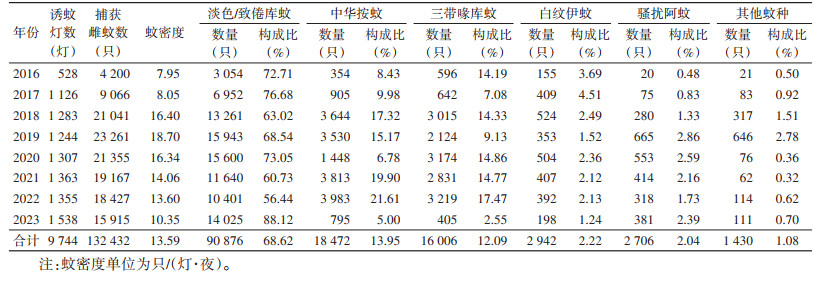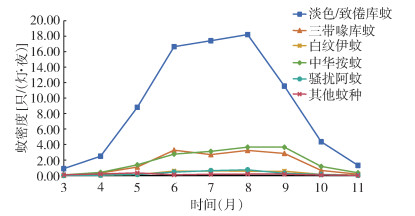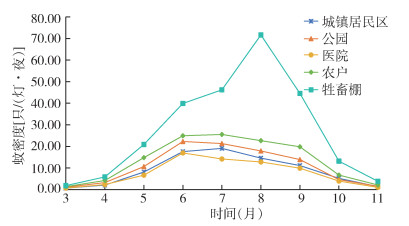扩展功能
文章信息
- 崔倩, 杨淑娟, 赵益超, 季羽茜, 王欢
- CUI Qian, YANG Shu-juan, ZHAO Yi-chao, JI Yu-qian, WANG Huan
- 江苏省盐城市2016-2023年蚊虫种群密度与季节消长监测结果分析
- Mosquito population density and seasonality based on surveillance analysis in Yancheng, Jiangsu Province, China, 2016-2023
- 中国媒介生物学及控制杂志, 2024, 35(3): 312-315
- Chin J Vector Biol & Control, 2024, 35(3): 312-315
- 10.11853/j.issn.1003.8280.2024.03.010
-
文章历史
- 收稿日期: 2023-12-07
盐城市位于中国东部沿海地区中部的黄海之滨,北亚热带向暖温带气候过渡地带,且受海洋影响较大,季风气候较明显,夏季湿热,雨量充沛,十分适宜蚊虫生长发育。蚊密度与蚊媒传染病之间存在复杂联系,条件适宜时可能暴发蚊媒传染病[1],为掌握盐城市蚊种构成、密度和季节消长趋势,以便在疾病高发季节前,及时采取蚊媒控制措施,阻断蚊媒传播疾病途径,为蚊媒传染病预测预警提供科学依据,现将2016-2023年盐城市蚊虫监测结果分析如下。
1 材料与方法 1.1 数据来源数据来自江苏省健康危险因素监测平台虫媒监测网络直报系统中盐城市填报的2016-2023年蚊虫诱蚊灯法监测数据。
1.2 监测方法依照《江苏省病媒生物生态学常规监测实施方案》,每年3-11月在盐城市9个县(市、区)开展成蚊监测,城区选择城镇居民区、公园和医院3类生境,农村选择农户和牲畜棚2类生境,每月上、下半月各监测1次。采用《病媒生物密度监测方法蚊虫》(GB/T 23797-2020)中的诱蚊灯法开展监测,将捕获的蚊虫用乙醚熏杀或冷冻的方式处死,鉴定性别、种类并计数。

|
采用Excel 2010和SPSS 20.0软件进行蚊密度监测数据整理和统计分析,对不同年份、不同生境的蚊虫构成比进行χ2检验,对蚊密度进行方差分析,对不同年份、不同蚊种的蚊密度进行方差分析趋势检验,P < 0.05为差异有统计学意义。
2 结果 2.1 不同年份蚊种构成及种群密度2016-2023年盐城市共布放诱蚊灯9 744台次,共计捕获雌蚊132 432只,平均蚊密度为13.59只/(灯·夜)。捕获的蚊种以淡色/致倦库蚊(Culex pipiens pallens/quinquefasciatus)、中华按蚊(Anopheles sinensis)、三带喙库蚊(Cx. tritaeniorhynchus)、白纹伊蚊(Aedes albopictus)和骚扰阿蚊(Armigeres subalbatus)为主,分别占捕获总数的68.62%、13.95%、12.09%、2.22%和2.04%(表 1)。2016-2023年淡色/致倦库蚊、中华按蚊、三带喙库蚊、白纹伊蚊、骚扰阿蚊和其他蚊种的平均蚊密度分别为9.33、1.90、1.64、0.30、0.28和0.15只/(灯·夜)。不同年份蚊种构成比差异有统计学意义(χ2=9 026.399,P < 0.001),不同年份蚊密度差异无统计学意义(F=0.211,P=0.981)。不同年份蚊密度趋势变化差异无统计学意义(F=0.096,P=0.758),不同蚊种的蚊密度和变化趋势差异均有统计学意义(F=66.264,P < 0.001;F=204.714,P < 0.001)。

|
不同生境中蚊密度最高的是牲畜棚,为28.37只/(灯·夜),最低的是医院,为7.84只/(灯·夜)(表 2)。不同生境间蚊种构成比差异有统计学意义(χ2=2 112.654,P < 0.001),经方差分析,不同生境间蚊密度差异有统计学意义(F=11.882,P < 0.001),其中淡色/致倦库蚊、中华按蚊、三带喙库蚊、白纹伊蚊和骚扰阿蚊密度在不同生境间的差异均有统计学意义(均P < 0.05)。

|
2016-2023年不同蚊种、不同生境各月合计的蚊密度季节变化曲线总体呈单峰分布,密度高峰均集中在6-9月。三带喙库蚊的密度峰值出现在6月,白纹伊蚊的密度峰值出现在7月,淡色/致倦库蚊、中华按蚊和骚扰阿蚊的密度峰值均出现在8月(图 1)。公园和医院的蚊密度峰值均出现在6月,城镇居民区和农户的蚊密度峰值均出现在7月,牲畜棚的蚊密度峰值出现在8月。见图 2。

|
| 图 1 2016-2023年盐城市不同蚊种密度季节消长趋势 Figure 1 Seasonality of mosquito density by species in Yancheng, Jiangsu Province, 2016-2023 |
| |

|
| 图 2 2016-2023年江苏省盐城市不同生境蚊密度季节消长趋势 Figure 2 Seasonality of mosquito density by habitat in Yancheng, Jiangsu Province, 2016-2023 |
| |
盐城市2016-2023年蚊密度监测结果显示,2019年蚊密度最高,与金彬彬等[2]报道的杭州市、胡雅劼等[3]报道的四川省监测结果相一致,这可能与该年降水量相对较多有关[3]。从蚊种来看,捕获的蚊种主要有淡色/致倦库蚊、中华按蚊、三带喙库蚊、白纹伊蚊和骚扰阿蚊,优势蚊种为淡色/致倦库蚊,与南京市[4]、淮安市[5]的调查结果相一致;其次是中华按蚊和三带喙库蚊,与南京市监测结果一致[4, 6]。不同生境中蚊虫种类构成稳定,其中淡色/致倦库蚊占绝对优势,在5类监测生境中均有捕获,且构成比均排首位,说明淡色/致倦库蚊是盐城市蚊虫防治的重点目标。此外,捕获的白纹伊蚊相对较少,考虑这可能与监测时间、监测方法有关,白纹伊蚊白昼和黄昏吸血,但有研究发现日落前(16∶30-17∶00)白纹伊蚊数量占优势,日落后数量占比下降明显[7],成蚊诱蚊灯法捕获的数量较少,但仍可以客观反映白纹伊蚊的季节消长趋势,采用蚊幼虫监测、人诱停落等方法作为补充可使监测数据更为准确、全面[6]。骚扰阿蚊同样不易被诱蚊灯所捕获[8],捕获量也相对较少。
从监测生境来看,牲畜棚的蚊密度最高,其次是农户和公园,该结果与南京调查结果一致[4, 6]。这可能与环境设施、卫生条件、蚊虫孳生地治理以及蚊虫的嗜血习性有关[9],提示防制蚊虫的重点区域在农村,农村基础设施建设相对薄弱,环境卫生相对较差,为蚊虫提供了孳生场所。因此应进一步加强农村人居环境治理,加大病媒生物防治知识宣传力度,保持良好的卫生环境,选择科学合理的时间和治理措施,清除蚊虫孳生地,有效降低蚊虫密度。
从季节消长趋势来看,8年来不同蚊种的蚊密度季节变化曲线总体呈单峰分布,6-9月为高峰期。淡色/致倦库蚊的密度高峰值出现在8月,这与南京和天津市的监测结果基本一致[4, 10]。本次监测结果显示,不同生境不同蚊种的活跃时间存在差异,提示应在不同蚊种活跃高峰期来临前采取相应的防制措施,此外,蚊密度季节消长情况与气象条件密切相关,受到温度、湿度和降雨量等气象因素的影响[1],盐城市地势平坦,四季分明,夏季湿热,雨量充沛,适合蚊虫的孳生和繁殖,提示要常态化开展城乡环境卫生整治行动,同时要加强蚊密度监测,根据蚊虫季节消长特点,及时清理和破坏蚊虫的孳生地,从源头上减少蚊虫孳生,在蚊虫活动高峰期时轮换使用不同作用机制的卫生杀虫剂,通过物理、化学等综合防控措施将蚊虫密度控制在低水平,有效预防蚊媒传染病的发生和流行[11]。
多年来,盐城市已先后发生或流行的蚊媒传染病有流行性乙型脑炎、登革热、疟疾等。通过分析历年蚊虫监测数据,可以基本掌握盐城市蚊虫的种类构成、密度分布和季节消长趋势,以便在疾病高发季节前,及时采取蚊媒控制措施,阻断蚊媒传播疾病途径,为盐城市蚊媒传染病的预防和控制提供科学依据及数据支持。
利益冲突 无
| [1] |
高文, 马丽华, 黄钢, 等. 河北省2013-2015年蚊媒传染病与蚊密度相关性分析[J]. 中国媒介生物学及控制杂志, 2016, 27(4): 350-353. Gao W, Ma LH, Huang G, et al. Analysis on correlation between mosquito-borne diseases and seasonality of mosquito density in Hebei Province from 2013 to 2015[J]. Chin J Vector Biol Control, 2016, 27(4): 350-353. |
| [2] |
金彬彬, 韦凌娅, 曹阳, 等. 杭州市2017-2021年蚊虫种群密度与季节消长监测结果分析[J]. 中国媒介生物学及控制杂志, 2023, 34(3): 351-355. Jin BB, Wei LY, Cao Y, et al. An analysis of mosquito population density and seasonal fluctuation monitoring results in Hangzhou, Zhejiang Province, China, 2017-2021[J]. Chin J Vector Biol Control, 2023, 34(3): 351-355. DOI:10.11853/j.issn.1003.8280.2023.03.012 |
| [3] |
赵宁, 郭玉红, 吴海霞, 等. 2019年全国媒介蚊虫监测报告[J]. 中国媒介生物学及控制杂志, 2020, 31(4): 395-400. Zhao N, Guo YH, Wu HX, et al. National vector surveillance report on mosquitoes in China, 2019[J]. Chin J Vector Biol Control, 2020, 31(4): 395-400. DOI:10.11853/j.issn.1003.8280.2020.04.003 |
| [4] |
杨淼, 孙燕群, 甘承新, 等. 2018年南京市江宁区蚊虫监测分析[J]. 中华卫生杀虫药械, 2019, 25(5): 437-440. Yang M, Sun YQ, Gan CX, et al. Monitoring and analysis of mosquito ecology in Jiangning District of Nanjing City in 2018[J]. Chin J Hyg Insect Equip, 2019, 25(5): 437-440. DOI:10.19821/j.1671-2781.2019.05.012 |
| [5] |
周小青, 陈夕鹏, 吕蒙蒙, 等. 江苏省淮安市2018-2022年成蚊种群密度与季节消长监测分析[J]. 中国媒介生物学及控制杂志, 2023, 34(4): 497-500. Zhou XQ, Chen XP, Lyu MM, et al. Adult mosquito population density and seasonal fluctuation in Huai'an, Jiangsu Province, China, 2018-2022[J]. Chin J Vector Biol Control, 2023, 34(4): 497-500. DOI:10.11853/j.issn.1003.8280.2023.04.010 |
| [6] |
孙燕群, 李成国, 姚美雪, 等. 2016年南京市蚊虫密度和种群分布的调查研究[J]. 中华卫生杀虫药械, 2018, 24(2): 138-142. Sun YQ, Li CG, Yao MX, et al. Investigation on mosquito density and population structure in Nanjing in 2016[J]. Chin J Hyg Insect Equip, 2018, 24(2): 138-142. DOI:10.19821/j.1671-2781.2018.02.008 |
| [7] |
高强, 周毅彬, 冷培恩, 等. 不同环境与昼夜时段成蚊密度的季节变化趋势研究[J]. 中华卫生杀虫药械, 2014, 20(6): 520-523. Gao Q, Zhou YB, Leng PE, et al. Seasonal variance of mosquito density in different micro-environments and circadian periods[J]. Chin J Hyg Insect Equip, 2014, 20(6): 520-523. |
| [8] |
杨维芳, 张育富, 刘大鹏, 等. 江苏省2008-2018年蚊虫种群消长研究[J]. 中国媒介生物学及控制杂志, 2021, 32(1): 45-51. Yang WF, Zhang YF, Liu DP, et al. A study of mosquito population variation in Jiangsu Province, China, 2008-2018[J]. Chin J Vector Biol Control, 2021, 32(1): 45-51. DOI:10.11853/j.issn.1003.8280.2021.01.009 |
| [9] |
田汶佳, 杜长慧, 邓良利, 等. 2016-2018年成都市成蚊密度监测[J]. 中华卫生杀虫药械, 2019, 25(4): 334-337. Tian WJ, Du CH, Deng LL, et al. Mosquito monitoring in Chengdu from 2016 to 2018[J]. Chin J Hyg Insect Equip, 2019, 25(4): 334-337. DOI:10.19821/j.1671-2781.2019.04.010 |
| [10] |
侯海光, 李培羽, 秦娜, 等. 2015-2018年天津市蚊虫密度监测结果分析[J]. 医学动物防制, 2020, 36(8): 798-800. Hou HG, Li PY, Qin N, et al. Monitoring results analysis of mosquito density in Tianjin from 2015 to 2018[J]. J Med Pest Control, 2020, 36(8): 798-800. DOI:10.7629/yxdwfz202008023 |
| [11] |
王纯玉, 张家勇, 白玉银, 等. 2020年辽宁省蚊虫密度与季节消长分析[J]. 中华卫生杀虫药械, 2022, 28(3): 230-233. Wang CY, Zhang JY, Bai YY, et al. Surveillance on mosquito density and seasonal fluctuation in Liaoning Province in 2020[J]. Chin J Hyg Insect Equip, 2022, 28(3): 230-233. DOI:10.19821/j.1671-2781.2022.03.011 |
 2024, Vol. 35
2024, Vol. 35

